The D-Day landings of mainland Europe on June 6, 1944 involved the most extensive wartime planning, with the most men and equipment, the world had ever seen. Over five thousand ships carried troops across the English Channel to Normandy, while eight hundred planes dropped thirteen thousand paratroopers who were the advanced attack force. A further three hundred planes bombed German forces while one hundred thousand allied troops stormed the beaches. The success of this operation was critical and, in fact, signaled the end of the war for Hitler who, once the allies made it safely ashore, was fighting two massive wars at opposite ends of his new empire.
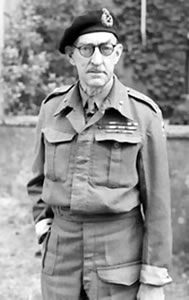 There were years of planning and speculation leading up to this point, and one of the major issues was how to get as many men as possible safely landed on the beaches of France and wreak havoc amongst the well trained German army once they got there. Out of this planning came a whole plethora of experimental tanks and Armored Fighting Vehicles; some seemingly crazy, some just looking crazy and some very effective. Major-General Percy Hobart, a world class leader in the training of British armored soldiers, was the figurehead of the British 79th Armoured Division, responsible for creating experimental and adapted tanks. This division was affectionately named “Hobo’s Funnies”, which the Major-General hated, but was considered by contemporaries and historians alike as his biggest achievement of WWII.
There were years of planning and speculation leading up to this point, and one of the major issues was how to get as many men as possible safely landed on the beaches of France and wreak havoc amongst the well trained German army once they got there. Out of this planning came a whole plethora of experimental tanks and Armored Fighting Vehicles; some seemingly crazy, some just looking crazy and some very effective. Major-General Percy Hobart, a world class leader in the training of British armored soldiers, was the figurehead of the British 79th Armoured Division, responsible for creating experimental and adapted tanks. This division was affectionately named “Hobo’s Funnies”, which the Major-General hated, but was considered by contemporaries and historians alike as his biggest achievement of WWII.
The Funnies were aptly named as they were a motley bunch of odd looking tanks adapted with propellers and wading screens to float and move through the water, spinning chains to flail the beached and detonate enemy mines, fold-out bridges on their roofs so other tanks could drive over the top of them and super-powered flamethrowers like fire-breathing dragons. The 79th Armoured Division played a vital role in supporting the allied invasion and the push all the way across the Rhine, by which point it had 21,000 men and 350 AFVs – about five times the size of a normal armored division, but operating in separate little pockets at the front of the advancing allied lines.
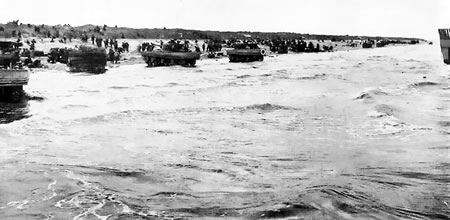 Most of the Funnies were built from the easily upgradable American Sherman M4 Medium Tank or the equally adaptable British A22 Churchill Infantry Tank Mark IV. Before the 79th Armoured Division was created, there had been a few adaptations in use such as the Valentine Amphibious Tank and the Canal Defense Light (so called to hide its true purpose), a high intensity beam designed to blind attackers at night which was used again to greater effect by the 79th Armoured Division during the allied liberation of Europe.
Most of the Funnies were built from the easily upgradable American Sherman M4 Medium Tank or the equally adaptable British A22 Churchill Infantry Tank Mark IV. Before the 79th Armoured Division was created, there had been a few adaptations in use such as the Valentine Amphibious Tank and the Canal Defense Light (so called to hide its true purpose), a high intensity beam designed to blind attackers at night which was used again to greater effect by the 79th Armoured Division during the allied liberation of Europe.
Some of the more widely used Funnies include:
Sherman DD (Duplex Drive)
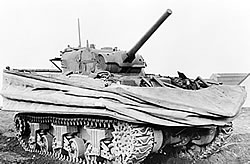 The first piece of equipment to land, ahead of the troops, was this amphibious tank that had a duplex drive, which could switch from driving the tracks to driving twin propellers in the water that were retracted when on land. They floated the tank with the aid of a watertight screen that was raised high from all side of the tank, like a big curtain around a hospital bed. The screen works on the principle that you can make something float by displacing a greater weight of water than the object you are floating. For instance, if your tank weighs
The first piece of equipment to land, ahead of the troops, was this amphibious tank that had a duplex drive, which could switch from driving the tracks to driving twin propellers in the water that were retracted when on land. They floated the tank with the aid of a watertight screen that was raised high from all side of the tank, like a big curtain around a hospital bed. The screen works on the principle that you can make something float by displacing a greater weight of water than the object you are floating. For instance, if your tank weighs 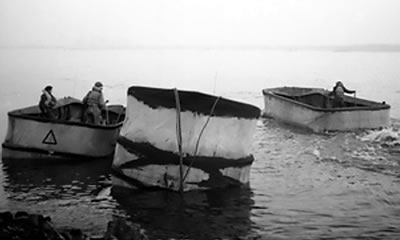 20 tons all you need to do is create a way of displacing more than 20 tons of water to make it float. So, in the case of the Sherman DD, the screen was raised to create a hole in the ocean that would have contained a heavier amount of water than the tank weighs, which meant that it floated. Of course it was still a very cumbersome machine to operate, and any significant leaks or incursions of water within the screen would cause the tank to sink, which many of them did when they were launched too far out to sea in high waves. However they did achieve a good degree of success on the British and Canadian Beach landings where they were launched in calmer waters.
20 tons all you need to do is create a way of displacing more than 20 tons of water to make it float. So, in the case of the Sherman DD, the screen was raised to create a hole in the ocean that would have contained a heavier amount of water than the tank weighs, which meant that it floated. Of course it was still a very cumbersome machine to operate, and any significant leaks or incursions of water within the screen would cause the tank to sink, which many of them did when they were launched too far out to sea in high waves. However they did achieve a good degree of success on the British and Canadian Beach landings where they were launched in calmer waters.
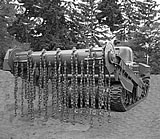 Sherman Flail/Crab
Sherman Flail/Crab
The Sherman Flail Tank, or Sherman Crab, was a regular Sherman gun tank with two arms protruding out front with a spinning roller between them. The roller had heavy chains with heavy metal lumps on the ends, so when the roller was spinning at speed the chain lumps would pummel the ground in front to the tank and detonate any landmines beneath the surface – thus creating a safe passageway for further tanks and soldiers to follow.
Churchill AVRE (Amoured Vehicle Royal Engineers)
 These were Churchill Mark III and IV tanks adapted to attack German forces and fortifications. They had an 11.42 inch/290 mm Petard Spigot Mortar fitted to them in place of their regular gun. The mortar fired a bomb called a Flying Dustbin, containing 40 lbs (18 kg) of High Explosives, up to 150 yards (137 m) that was capable of destroying concrete bunkers, pill-boxes and large obstacles in the road. The mortar had to be loaded externally, the same as a field mortar, so the tank had hatches on the side for the men to quickly get out and reload the mortar. The hatches also allowed the men to deploy any of a number of addition devices that were sometimes attached to this machine, such as: Fascines (rolled up bunches of sticks to fill trenches and ditches to allow tanks to cross), Bobbins (a reel of canvas with poles that could be laid over soft ground to allow itself, other vehicles and soldiers to cross), Small Box Girders (30 foot (9.1 m) girders that could be deployed across gaps, such as blown bridges, in 30 seconds to allow crossing) and the Bullshorn Plough ( a forward facing plow to dig the earth and detonate any mines.)
These were Churchill Mark III and IV tanks adapted to attack German forces and fortifications. They had an 11.42 inch/290 mm Petard Spigot Mortar fitted to them in place of their regular gun. The mortar fired a bomb called a Flying Dustbin, containing 40 lbs (18 kg) of High Explosives, up to 150 yards (137 m) that was capable of destroying concrete bunkers, pill-boxes and large obstacles in the road. The mortar had to be loaded externally, the same as a field mortar, so the tank had hatches on the side for the men to quickly get out and reload the mortar. The hatches also allowed the men to deploy any of a number of addition devices that were sometimes attached to this machine, such as: Fascines (rolled up bunches of sticks to fill trenches and ditches to allow tanks to cross), Bobbins (a reel of canvas with poles that could be laid over soft ground to allow itself, other vehicles and soldiers to cross), Small Box Girders (30 foot (9.1 m) girders that could be deployed across gaps, such as blown bridges, in 30 seconds to allow crossing) and the Bullshorn Plough ( a forward facing plow to dig the earth and detonate any mines.)
Churchill ARKs
This was a tank with its turret removed and a folding ramp added to the roof. The ramp would unfold to ground level so that other tanks, vehicles and troops could use it to easily overcome high obstacles like walls and large bunkers.
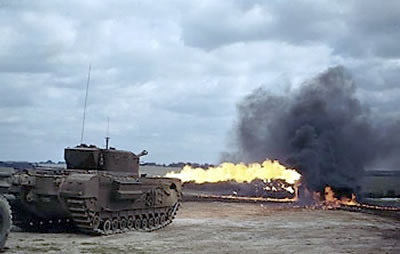 Many aspects of the D-Day landings could not have been accomplished without the Funnies, which assisted in crossing and breeching sea walls, crossing anti-tank ditches, destroying gun emplacements and well-defended buildings, crossing ditches and large artillery shell holes and clearing beach mines.
Many aspects of the D-Day landings could not have been accomplished without the Funnies, which assisted in crossing and breeching sea walls, crossing anti-tank ditches, destroying gun emplacements and well-defended buildings, crossing ditches and large artillery shell holes and clearing beach mines.
These and other Funnies carried on being used all the way into Germany, a very successful example being the Churchill “Crocodile” Flamethrower, which was fueled by a large gasoline tank towed behind and ejected a stream of flame 120 yards (120 m) in front of it, ideal for clearing out enemy bunkers.